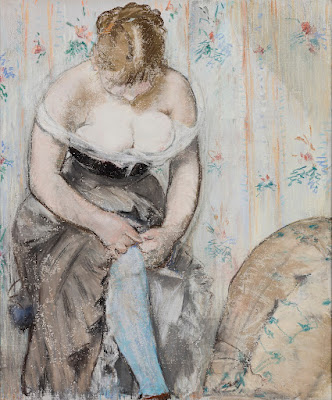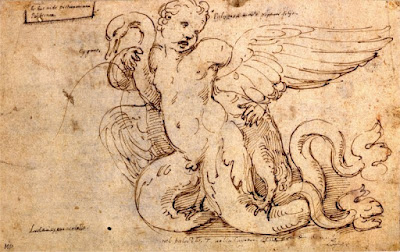 |
| Édouard Manet Le Linge 1875 oil on canvas Barnes Foundation, Philadelphia |
 |
| Édouard Manet The Garter Belt ca. 1878-79 pastel on canvas Ordrupgaard Art Museum, Copenhagen |
 |
| Édouard Manet Study of Madame Manet as a Convalescent 1878 etching Agnes Etherington Art Centre, Kingston, Ontario |
 |
| Édouard Manet Tarring the Boat 1873 oil on canvas Barnes Foundation, Philadelphia |
 |
| Giulio Romano Design for Grotesque Architectural Ornament before 1546 drawing Fitzwilliam Museum, Cambridge |
-Fitzwilliam-Museum-Cambridge.jpg) |
| Giulio Romano Design for Tazza (tableware design commissioned by the Duke of Mantua) ca. 1524-26 drawing Fitzwilliam Museum, Cambridge |
 |
| Giulio Romano and Workshop Design Study for Palazzo Te, Mantua ca. 1520 drawing Agnes Etherington Art Centre, Kingston, Ontario |
 |
| Giulio Romano Young Triton with Swan (ornamental motif) before 1546 drawing Musée Calvet, Avignon |
 |
| William Strang Dorothy 1911 drawing National Gallery of Canada, Ottawa |
 |
| William Strang Half-Length Figure Study ca. 1880-90 drawing Ashmolean Museum, Oxford |
 |
| William Strang Mid-day Meal 1883 etching Lyman Allyn Art Museum, New London, Connecticut |
 |
| William Strang The Prodigal Son 1882 etching Lyman Allyn Art Museum, New London, Connecticut |
 |
| Diego Velázquez Portrait of Elisabeth of France, first wife of Philip IV of Spain 1632 oil on canvas Kunsthistorisches Museum, Vienna |
 |
| Diego Velázquez Portrait of Mariana of Austria, second wife of Philip IV of Spain ca. 1652-53 oil on canvas Kunsthistorisches Museum, Vienna |
 |
| Diego Velázquez Portrait of the Infanta María Teresa, later Queen of France ca. 1652-53 oil on canvas Kunsthistorisches Museum, Vienna |
 |
| Diego Velázquez and Workshop Portrait of the Infanta María Teresa, later Queen of France 1653 oil on canvas Museum of Fine Arts, Boston |
from Part Three of The Age of Anxiety
Emble asked Rosetta to dance. The others sat watching. Quant waved his cigar in time to the music and sang a verse from an old prospector's ballad.
When Laura lay on her ledger side
And nicely threw her north cheek up,
How pleasing the plight of her promising grove
And nicely threw her north cheek up,
How pleasing the plight of her promising grove
And how rich the random I reached with a rise.
Whereupon Malin sang a verse of a folksong from a Fen District.
When in wan hope I wandered away and alone,
How brag were the birds, how buxom the sky,
How brag were the birds, how buxom the sky,
But sad were the sallows and slow were the brooks,
And how dismal that day when I danced with my dear.
And how dismal that day when I danced with my dear.
Moving well together to the music, Rosetta and Emble were becoming obviously attracted to each other. In times of war even the crudest kind of positive affection between persons seems extraordinarily beautiful, a noble symbol of the peace and forgiveness of which the whole world stands so desperately in need. So to dancers and spectators alike, this quite casual attraction seemed and was of immense importance.
Rosetta and Emble sang together:
Hushed is the lake of hawks
Bright with our excitement,
And all the sky of skulls
Glows with scarlet roses;
The melter of men and salt
Admires the drinker of iron;
Bold banners of meaning
Blaze o'er the host of days.
Hushed is the lake of hawks
Bright with our excitement,
And all the sky of skulls
Glows with scarlet roses;
The melter of men and salt
Admires the drinker of iron;
Bold banners of meaning
Blaze o'er the host of days.
– W.H. Auden (1944-46)